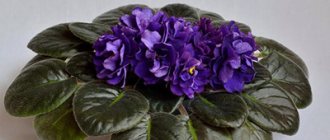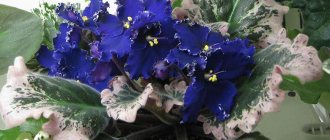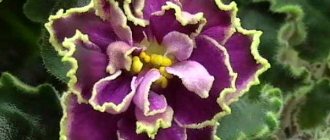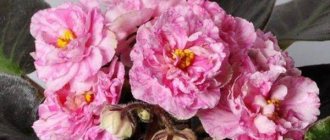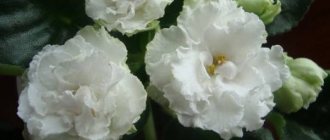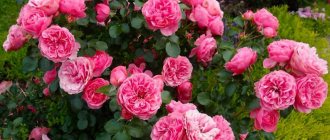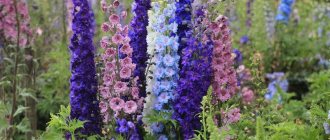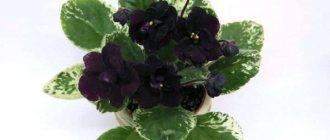In this article you will find the TOP 10 most popular varieties of red violets from breeders E. Lebetskaya, E. Korshunova, K. Morev and other famous breeders.
Violets naturally have blue or purple flowers. Over the years, breeders have worked to improve the varietal qualities of Uzambar violets, and the result of their work has been several thousand varieties of violets.
Today we have varieties with blue, white, pink, purple and even yellow flowers. The red varieties of Saintpaulia deserve special attention.
Red violets create a cozy atmosphere in the house; they go well with interiors decorated in white, cream, blue, yellow or brown tones.
This is a rather unusual color for the Uzambara violet, and every gardener has at least one of these varieties in his collection.
Breeders have not developed many pure red varieties; for this reason, coral and burgundy shades are indicated. Below you will see photos and names of red violets with their brief description.
Red violets: top 10 most popular varieties
LE Whipped cream
This unique variety, signed by Elena Lebetskaya, is the dream of many collectors.
The leaves are collected in a neat rosette with light leaves that curl slightly at the edges. The reverse side of the sheet has a red tint. The diameter of the rosette reaches 17 centimeters.
Whipped cream flowers are very large, double, and resemble whipped cream. There is a flounce along the edge of each petal that adds airiness. There is no uniform color; crimson streaks appear randomly and depend on the time of year, temperature and lighting.
The flower size reaches 6 centimeters.
Note! The author described its variety as follows: “The flowers are large, white, with a thin wavy crimson border running along the edge of the petal.” All other options are sporty.
LE Summer red
Saintpaulia from Elena Lebetskova is distinguished by a large, uniform rosette and long, bright green leaves.
The flowers are large, dark red or burgundy in color, reaching 7 centimeters in diameter. There is a wavy white border along the edge of the petals.
Blooms profusely and forms a beautiful bouquet. The color of the petals may change depending on the lighting or air temperature.
EK Bullfight
This is a variety from the author Elena Korshunova. A distinctive feature of bullfighting is its very large flowers, reaching 8 centimeters. The rosette of large leaves is dense and grows up to 30 centimeters in adulthood.
Color varies from ruby to bright scarlet. Saturation depends on the conditions of detention.
This variety does not form rosettes, but this does not affect its attractiveness, since all the flowers are large and the flowering period is long.
The plant needs regular feeding, good lighting and regular removal of the lower leaves.
Gold
Very often, subsequent generations of the Fight by Bulls variety do not possess the main varietal characteristics. But sometimes worthy examples appear, for example, Fight of the Bulls Gold.
This variant has a variegated rosette with a light dot in the center.
LE Ruby Mongols
The author of the Saintpaulia hybrid is Elena Lebetskaya.
The color of the petals has a ruby tint, which was the reason for the name. The flowers are large, slightly velvety to the touch, and have a small wavy border at the edges. When given enough light, these flowers shine and have a dark spot in the center.
This variety does not form caps; it usually blooms from 3 to 5 flowers, but this is compensated by a long flowering period (up to 6 months). After a short rest, Saintpaulia resumes flowering.
Rubin Monogolov prefers bright lighting. But if a specimen of this variety has been in partial shade for a long time, then this plant cannot be exposed to harsh sun - there will be burns on the leaves. This needs to be done gradually.
Ruby Mongols violet leaves are dark green and glossy, forming a beautiful rosette.
Frosty cherry (Morev)
This variety from Konstantin Morev has large double flowers up to 4 centimeters in diameter. The color is white, with a large cherry spot in the center.
Sometimes Frosty Cherry changes color intensity, the flowers can be completely white with a small pink spot, and sometimes deep crimson.
The leaves are round and form a beautiful rosette. The plant does not like drafts. The color does not depend on the conditions of detention.
The value of the variety lies in its long flowering period (10 months) and good response to fertilizing.
Carefully! In very hot conditions, many Saintpaulias are whiter in color, and in winter the petals develop a dark red or burgundy color.
LE Polina Viardot
Variety of Elena Lebetskaya. The rosette is large, the leaves are variegated, they prefer not to lie horizontally, but to bend slightly.
The flowers are single and double, with a wavy white border along the edge. Pauline Viardot does not form a large bouquet, but this is compensated by large flowers on a variegated rosette.
This variety grows very slowly and does not begin to bloom until it has become a large rosette.
For propagation, leaves with a lot of greenery are chosen, and the babies are planted as late as possible so that green spots form on them. Old and young leaves are not suitable for propagation.
Hummingbird (K. Morev)
Variety of Konstantin Morev. The flower shape is pansy. Color: red with a wavy light green edge.
The rosette is very compact, small, this variety can be grown as a semi-standard variety.
Carefully! Hummingbirds react very poorly to bright light. The leaves take on an unsightly yellow or brown tint and begin to bend. Short stems can be deformed. Flowering time is significantly reduced. The recovery period is very long. This variety needs to be shaded immediately.
AV Tango (Violetgrower)
The uniqueness of the variety lies in the unusual bright color of the beets. Breeder - Vyalkovod.
The flowers are large, double, and velvety to the touch. Large flower stalks hold weight well and do not fall off.
The peculiarity of the variety is that when cuttings are taken, the peduncle first grows, and then the leaves appear.
Bright green leaves form a single rosette.
EK Agate tulip
The variety of breeder Elena Korshunova got its name from the shape of the flower, reminiscent of an open tulip.
The color of the flowers is salmon, the shape can be simple and terry, and does not depend on the conditions of detention. The size of the flowers reaches 6 centimeters. The peduncles are small and strong, do not fall out and hold on well.
The leaves are dark green with a red tint inside. Forms a uniform, beautiful large rosette.
EC Gardens of Babylon
Varieties author Elena Korshunova. It has large double flowers of red color with a rich coral tint. The stems of the flowers are elongated, the flowers droop slightly, which makes them look like pompoms.
Flowering cascading. Over time, the color becomes darker. Babylon purple gardens look beautiful in hanging pots. The leaves are small, but the long cuttings form a wide rosette.
This variety needs a lot of space. The plant must be regularly rejuvenated and side shoots removed.
Sport Shanghai Rose, which you see in the photo below, has folded peduncles, a white border along the edge of the petal, and is unstable.
Flowering of new items from my collection EK-Lyubasha, Inner Strength, LE-February Morning, etc.
Good day, dear forum users and site guests! It's time to report on the flowering of the next batch of new items in my collection. I'll start with the standards. I have been waiting for the beauty EK-Lyubasha for many years, and she came to me as Elise, and only after publication it became clear what her real name was, otherwise I was tormented by vague doubts due to the discrepancy between the description and online portraits of Elise and that one beauty that grows in me.
It just so happened that instead of a baby, they sold me 3 tiny juvenile leaves stuck in peat slurry. Subsequently, only one of these leaves survived and produced a single baby, which sat for more than a year without being able to bloom. A year later, the baby obtained from the leaf of my rosette bloomed with a single peduncle:
And only after I planted a leaf from under this peduncle, I was able to wait for the offspring, which bloomed without any problems, as befits this wonderful variety:
The flowers are very dense and delicate in appearance, but last a very long time, at least 4 weeks each. At the same time, new flower stalks have been appearing tirelessly for the third month in a row:
This beauty’s rosette is not small, about 35 cm, so I keep it in a basket on the coffee table, which makes the flower incredibly happy:
Inner Strenght did not present any problems in growing; I received this variety last summer from Natasha Shalamova with a leaf, which very quickly acquired many children. The first of them bloomed already in early April. The flower is very bright and memorable:
A rosette of ideal shape with beautiful variegation:
Natural color is reflected well in the sun, but in a room under lamps the camera tends to distort it:
This is already the second rosette, and the first one stood for more than a month with a dense bouquet, then it rested for 3 weeks, growing foliage that was lost at the exhibition, and now it has started throwing out flower stalks again:
Closer flowers:
I also grew the beauty LE-February Morning from a leaf purchased a year ago. The variety is just a dream for lovers of double flowers:
The flowers are large, dense, form an elegant bouquet above a neat curly rosette of modest size - about 25 cm:
I took it to the Kyiv exhibition half-opened, so I was in a hurry to photograph it in all its glory before the rosette lost its leaves:
And despite the fact that she was pinched quite a bit, the girl recovered very quickly and acquired a lush head of “long-lasting” flowers:
I got Ma's Grape Eskape 2 years ago. The leaf did not want to bear fruit for a very long time, the first baby appeared only six months after planting, but it bloomed quickly enough, it’s a pity it was not quite the same variety - there was no green border and the flowers themselves began to turn purple. I was so impatient to wait for flowering that I planted the leaves from this rosette long before the flower stalks appeared:
I planted it “at random” and it turned out that it was not in vain: a white bud has already appeared on the young rosette, so perhaps the new rosette will be a varietal one. And the next baby acquired the most magnificent peduncle on the uterine leaf, I counted as many as 10 buds on it:
The most joyful thing is that the flowering turned out to be varietal:
What’s even happier is that all 10 buds gradually opened, not a single one withered:
Rebel's Rose Bud did not make much of an impression at the beginning of flowering, but gradually the “ugly duckling” turned into a beautiful swan:
The flowers are quite large for a compact 18 cm rosette and last a very long time for this color - considering that it was hot for almost a month, the first signs of wilting appeared only after 4 weeks, during this time the flowers did not wilt and almost did not discolor, and the slightly plucked rosette straightened out and acquired an almost perfectly round shape:
Amadeus, with all the beauty of the flower, has a rosette from the “hug and cry” series; you have to run around with it a lot on the shelves to find the ideal place for its formation:
I bought the first plant when I was a child; the cuttings on it were very elongated. After replanting and placing it under a bright lamp, the leaves curled down, so I had to move it under the flora, where the cuttings began to stretch out again. It was almost impossible to remove the bottom row without ruining the shape of the rosette, but I really wanted to wait for flowering. Caprisulya produced one peduncle in order to quickly grow the second generation, I immediately planted a leaf from under it:
The second flowering was very different from the first:
And in winter the rosette bloomed almost completely white:
The offspring obtained from the leaf bloomed faster, although the rosette was not particularly beautiful either:
I was very pleased with the fact that the flowers themselves turned out to have a varietal color and lasted a very long time, more than a month each:
Only with age did the flower stalks begin to bend slightly:
I still managed to achieve a relatively even socket; the ideal place was the third shelf of the rack with not the brightest lighting:
EK-Madagascar is not a new variety, rather even retro, I received it as a child from Tatyana Maksimovskaya. I don’t have the best relationship with Korshunova varieties; they all require a lot of natural light, so they bloom reluctantly in our dark apartment. But this variety turned out to be a pleasant exception: the rosette grew without problems on the kitchen shelf away from the window under an ordinary lamp, formed just perfectly without the slightest problem and threw out its flower stalks in unison:
The flowers were not very large at first, but in 2 weeks they reached a size of 5-6 cm. Their color is perfectly conveyed in the sun:
The rosette at the exhibition lost most of its leaves, and continued to proudly hold a dense, non-fading bouquet for more than a month:
LE-Meissen Sport Porcelain also came to me from Tatyana Maksimovskaya. Interestingly, Tatyana’s Siamese twin of this rosette bloomed with varietal flowers - white with a blue ruffle.
On my rosette, the first flowers appeared with only small white splashes, and all subsequent buds opened pure blue:
At first, I thought of getting rid of an off-grade plant with terribly fragile leaves - they break at the slightest awkward touch, but the flowers turned out to be so persistent and attractive in appearance that I decided to keep this plant as a sport:
RS-Kapitoshka came to me from the same source as the previous outlets:
The first flower opened quite quickly, but did not make an impression; there was too little blue on it, and there were no white splashes at all:
I decided to wait, and the grateful plant hastened to console me:
The ideal bouquet began to form quite quickly over the ideal compact rosette:
And with the onset of heat, the flowers began to become darker and darker:
All this beauty had only one significant drawback: the flowers begin to fade already on the 10th day:
N-Shurok is considered a semi-miniature, but it can safely be classified as a small standard, both in the size of the rosette - 20-24 cm, and in the size of the flowers - 3-4 cm:
The flowers open quite brightly and look elegant above a perfectly round dark curly rosette:
The bouquet grows gradually, the flowers quickly turn pale, but do not lose their freshness:
They are very dense and last a record long time for this color - about 2 months each. Over time, yellow streaks appear in the center of the flowers, giving them a waxy appearance:
The bouquet does not lose its shape until the last day and the plant itself is absolutely not picky.
Now let's move on to the miniatures. I have also had Ruby Wedding Lux for three years now, I grew it from the leaf and there were a lot of “dances with tambourines” around this variety during this time:
The very first flower was simply magnificent, but the rosette didn’t spoil me with flowering again for almost a year,
Only after the third transplant and rearrangement under the LEDs did flower stalks appear on it:
The flowering coincided with the arrival of the heat, so the flowers very quickly began to shrink, and on both rosettes, besides, the older rosette had been curling its leaves down all this time, and with age, the young rosette began to do the same:
The semi-mini N-Silver Smoke has all of my favorite qualities: interesting foliage, beautiful blue color and a flower shape with a white edge:
But it’s quite difficult to expect a beautiful bouquet from her, the flowers open slowly and wither quickly, the flower stalks are long, and the leaves stubbornly hug the pot:
So, for all its beauty, the rosette is quite unphotogenic and looks like a ballerina with an inopportunely untied lace on a ballet shoe:
N-Light Sadness, on the contrary, is the ideal of durability, its delicate half-open bells last for a very long time, and the rosette itself is almost perfect:
The first flowers opened with a slight pink tint, which subsequently disappeared:
There are a huge number of buds, they open very slowly. A small rosette no more than 10 cm with interesting elongated foliage:
This is what it looks like 2 months after the start of flowering; since then I haven’t removed a single flower:
Half-mini Rob's Zipper Zapper is just a dream for a violet lover: a perfectly even rosette, fantastic fertility and huge 4-5 cm flowers above a 12 cm rosette:
True, it’s worth raising all the children until they bloom, because you might end up with something like this:
The sportswoman is inferior to its varietal sister both in flower size and color:
The flowers differ in shape and size, but form a harmonious, long-lasting bouquet over a perfectly even rosette:
Rob's Mango Mongo is another large-flowered semi-miniature, I've had it for the second year now, but at first I thought that I got a sporty version, since in the center of the flowers there were no shiny dots assigned by the variety, like a cut fruit:
In addition, the variegation quickly went away, but this often happens if plants are kept on a shelf:
And only in the second year did my Mango have varietal marks on the flowers; I hope they will appear faster in the second generation:
I tried to plant the beauty Mac's Momentary Meltdown several times, but every time the white sport bloomed, no matter what sources the planting material came from. I was already completely desperate to see this beauty, but last fall I took the risk of buying a leaf from a flowering plant again:
This time, too, there were sports, but 2 rosettes, left for themselves, threw out dark buds and bloomed according to the variety:
It was so nice to watch how the blue cloud grew over the even rosette!
That’s all for now, I’ll tell you about my other new products when enough photographic material becomes available. Thank you for your attention.
Care Tips
Saintpaulias prefer small containers. For a standard pot, a pot with a diameter of 8 cm is suitable; a semi-standard one will feel good in a 6-7 cm pot. If you assemble a larger pot, nothing bad will happen, but such a plant will bloom much later.
Saintpaulias need light soil that allows air to pass through, otherwise the roots will begin to rot.
To achieve good results, the following conditions must be met:
- diffused light;
- absence of drafts;
- proper watering;
- regular feeding.
